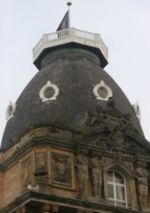Grand Hotel (Scarborough)
The Grand Hotel is a large hotel in Scarborough, England, overlooking the town's South Bay. It is presently owned by Britannia Hotels,[1] and is undergoing a £7 million refurbishment.
The hotel was designed by the Hull architect Cuthbert Brodrick,[2] and when completed in 1867,[3] was one of the largest hotels in the world, as well as one of the first giant purpose-built hotels in Europe. The hotel's distinctive yellow brickwork was made locally in Hunmanby.
The building is designed around the theme of time: four towers to represent the seasons, 12 floors for the months of the year, 52 chimneys symbolise the weeks, and originally there were 365 bedrooms, one for each day of the year.
The hotel's heydey was arguably during Victorian times, when wealthy holidaymakers made up the establishment's clientele. As Scarborough was a famous spa town, the building's baths originally included an extra pair of taps, so guests could wash in seawater as well as fresh.[4]
The hotel was badly damaged when the German Navy bombarded the town in 1914.
Nowadays, the hotel caters towards the budget end of the spectrum. The hotel was bought by Butlins, the company better-known for its holiday camps, in 1978, and run as an inexpensive choice of accommodation until it was sold to Britannia in 1998.
Three blue plaques outside mark where the novelist Anne Brontë died in 1849, the contribution of the RAF trainees stationed at the hotel during World War II, and the original opening of the building.
Controversy
- Several cases of sickness were reported in the mid-1990s under previous ownership, and in 2002 an outbreak of gastro-enteritis hospitalised one man and affected more than 200 guests and staff. A month later, 54 people fell ill, leading to ten days' closure to carry out cleaning.[5]
- In October 2004, a number of guests were quarantined in their rooms due to reports of sickness. Following this, in December, the hotel shut for ten days due to an outbreak of the Norwalk virus. This incident, in which no-one required hospital treatment, closed the establishment for several days. A spokesperson for the North Yorkshire Health Protection Unit blamed the incidents on the age of the building and "bad luck".[6]
- In 2005 an investigative BBC report revealed several health issues at the hotel, including the presence of e-coli bacteria.[7]
- In 2006 the hotel was fined £10,000 after a guest drank water that contained dangerous levels of bleach.[8]
- In May 2006, a fire broke out on the sixth floor of the building, possibly caused by renovation work. The hotel was quickly evacuated while local fire crews dealt with what they described as "quite a severe fire". Extinguishing the blaze took over 40 minutes, due to the number of stairs in the building and the amount of smoke, which both hampered firefighters' movements.[9]
- In September 2006, the management installed extra netting and spikes on the exterior of the building to deter nesting seagulls. The birds, which are regarded as a nuisance in parts of the town, had been disturbing guests with mating calls. Their droppings were also responsible for a significant proportion of the hotel's cleaning expenses.[10]
References
- ↑ The Grand Hotel, Scarborough - Britannia hotel home page.
- ↑ Britain's Best Breaks. Broderick was better known as the designer of several Leeds buildings.
- ↑ Grand Hotel blue plaque - Wikipedia.
- ↑ BBC North Yorkshire - Walk through Time.
- ↑ Hotel May Reopen Tomorrow after Outbreaks of Sickness. Yorkshire Post, 22nd December 2004.
- ↑ Hotel May Reopen Tomorrow after Outbreaks of Sickness Yorkshire Post, 22nd December 2004.
- ↑ BBC Inside Out - Hotel not-so-Grand.
- ↑ Chartered Institute of Environmental Health.
- ↑ Blaze drama at the Grand. Scarborough Evening News, 8th May 2006.
- ↑ Hotel bid to evict. Scarborough Evening News, 22nd September 2006.
Links
- Grand Hotel, Scarborough - official site.
- North Yorkshire Health Protection Unit


